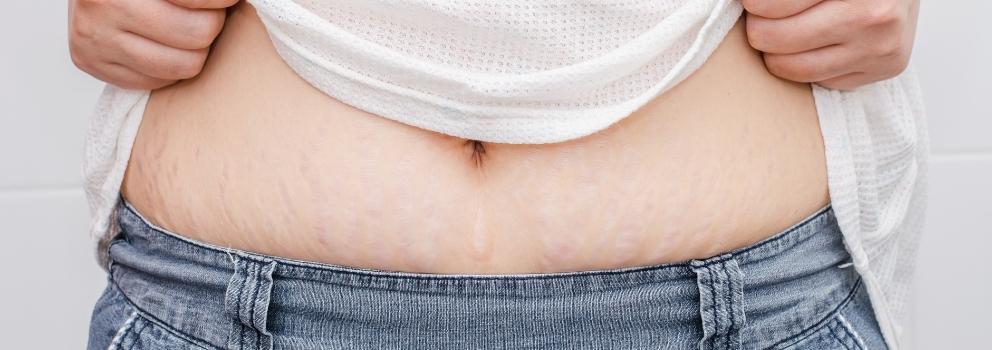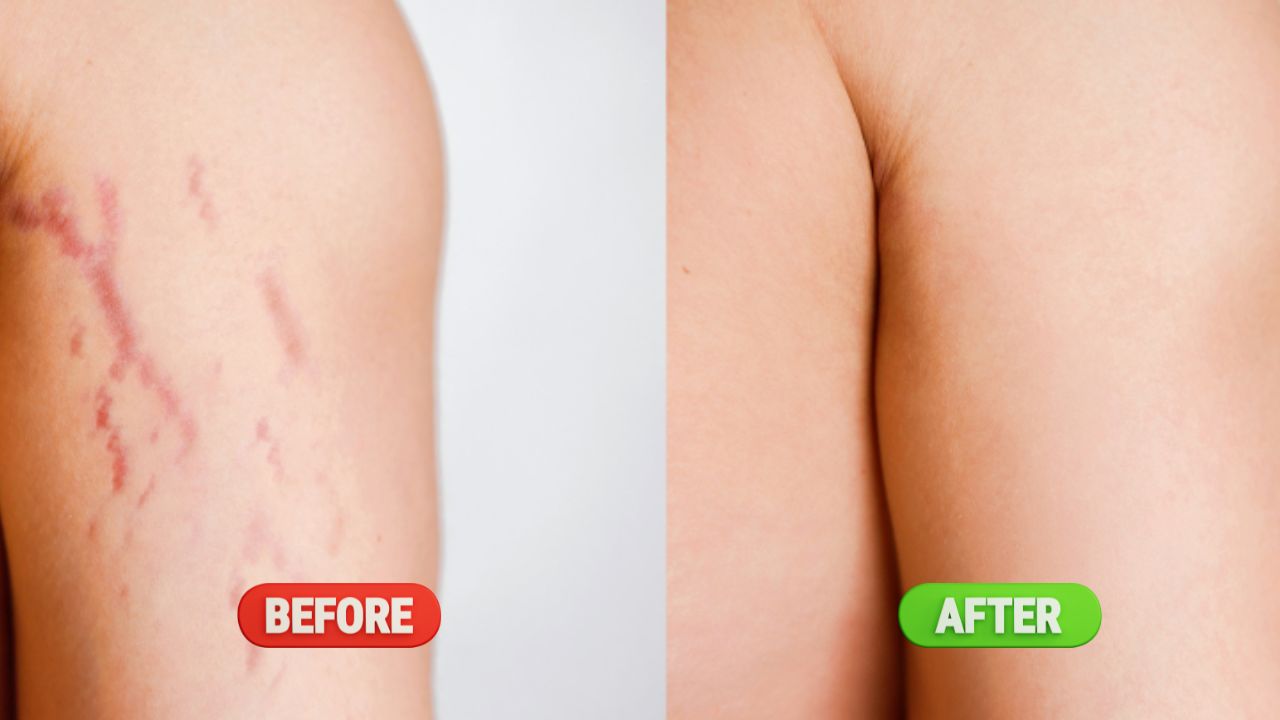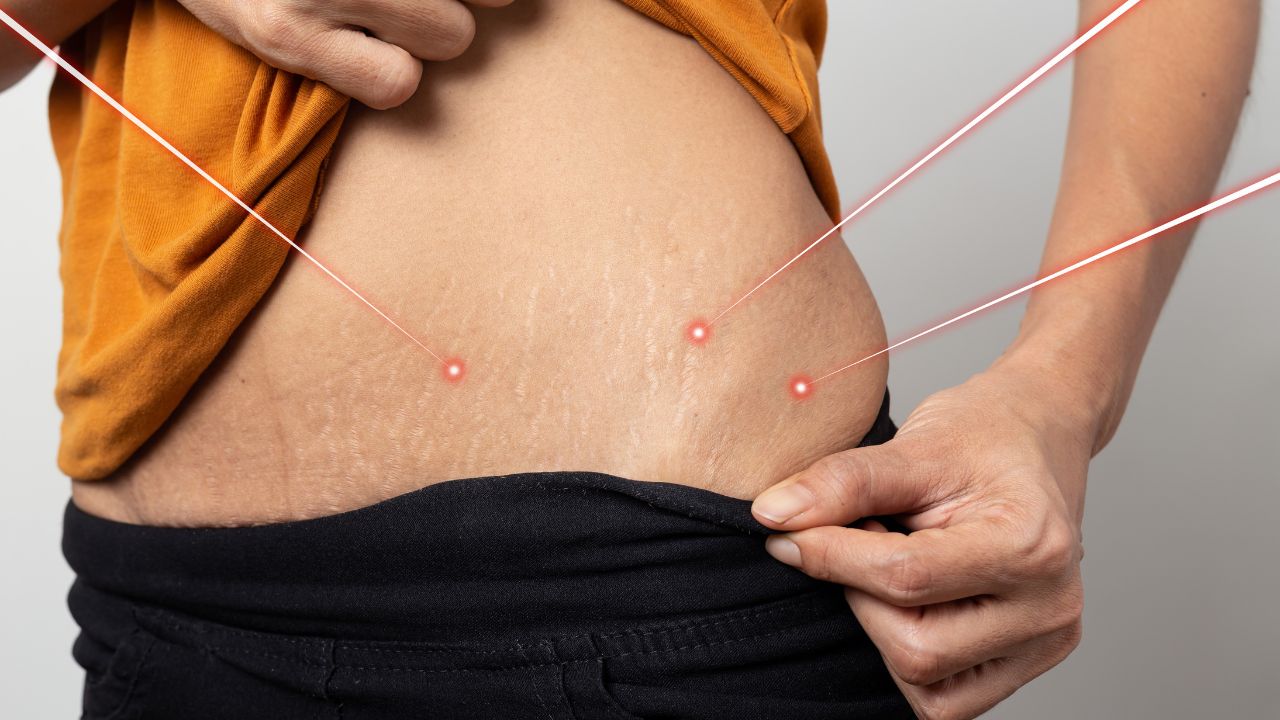CALL US NOW +1-844-669-0939

PRP - Platelet Rich Plasma for Stretch Marks
Platelet rich plasma therapy with microneedling and PRP injections are an effective treatment option for stretchmarks and scars. When we lose weight, gain curves, or have a child, our rapid change in shape will leave behind a series of thin, horizontal white, red, or purple lines: stretch marks. Medically-termed striae, stretch marks are formed due to small tears on the skin as it expands and shrinks back again.
Stretch marks don’t indicate any serious condition, but they can be embarrassing or act as a reminder of painful events. In addition, they can be hard to treat, especially once they are old.
Platelet-rich plasma for stretch marks (sometimes jokingly called “vampire facials”) is one of the newest and most effective ways to reduce the appearance of stretch marks, scars, and loose skin areas.
What is Platelet-Rich Plasma treatments?
Platelet-rich plasma treatments are an experimental form of regenerative medicine that uses a person’s own blood to promote faster healing, tissue regeneration, and improved wellness.
To make platelet-rich plasma, we first need to extract some of your blood. This blood will then be centrifuged to separate its platelets (the small cells responsible for scarring and healing) from red blood cells or stem cells and its liquid components (plasma). Then, we will remix this into a new fluid with a higher concentration of platelets in the same volume and inject it directly into the areas that we wish to restore.
How does PRP work?
Platelets are among the smallest and densest of all blood components. They have two main jobs: first, they kickstart the “clotting cascade” that quickly closes a wound after you’ve been injured. Next, they also contain a hormone known as growth factor, which promotes collagen production.
Collagen, of anti-wrinkle fame, is a protein responsible for the elasticity of our skin, joints, and blood vessels. This rush of new collagen can be used to:
- Repair knee or joint injuries
- Make the skin more supple
- Improve irrigation and sensitivity of specific areas, such as sexual organs
- Help with hair restoration after androgenetic alopecia (hormonal hair loss)
So, does PRP work on stretch marks? The short answer is yes. It is a powerful, well-rounded method of improving regeneration wherever applied.
What are the benefits of platelet-rich plasma for stretch marks?
Using a PRP injection for stretch marks offers several benefits over its competitors.
It can visibly reduce white stretch marks
Stretch marks are easier to heal when they appear, immediately following weight gain. At this stage, the lines still look deep purple or red. The lines will become light pink and eventually silvery-white as the skin tissue heals. Typically, these “healed striae” are considered permanent, and most creams or lotions will not affect them. However, PRP injections are a more effective treatment and can achieve more visible results.
It will reduce the recovery time from standard micro-needling
Many advanced treatments against stretch marks, such as micro needling or chemical peels, will likely leave your skin irritated and sore for a few weeks. PRP can cut the recovery process in half or even less, and you may be ready for the beach after less than a week.
It will fortify your skin anew
The platelets released by PRP will quickly promote a rush of collagen and elastin, two compounds with numerous applications in dermatology.
A PRP injection will make the skin in the area look tighter and firmer, but without the rigidity of botox or fillers.
This can be a game-changer if you’ve recently lost weight and have deep stretch marks on your arms and breasts. If you have any sunspots or acne scars in the area, PRP injections can also help diminish them.
Can PRP Microneedling be used to treat scars as well?
Yes! PRP for stretchmarks as well as PRP micro-needling can be used and is effective in the treatments of scars and scar tissue. Research has shown that there is a significant improvement of scar tissue after multiple PRP therapy sessions. Typically scan tissue is less inflamed appearing and visible after multiple treatments.
A study performed by Ahmed and Mostafa included 45 patients with skin types III and IV (Fitzpatrick) with both striae albae (scar tissue) and striae rubrae (stretch marks). They were then grouped into two groups evenly with 10 scar tissue patients and 5 stretch mark patients per group (15 patients each). Group A was treated with a laser therapy called carboxytherapy or CO2 laser), group B received treatment with PRP, and group C received radiofrequency therapy (RF).
The treatments were performed every week for a total of 5 sessions. The study revealed improvement in all three groups. Patients who underwent PRP treatments had a less visible scar and stretchmark appearance with thicker and healthier appearing skin. Histopathological findings under the microscope for scars, 3 months after treatment with PRP demonstrated an increase in epidermal thickening with formation of rete ridges and decrease in perivascular infiltrate. Additionally, there was an increased number of collagen fibers and elastic fibers. The fibers were longer, thicker, and more evenly arranged. [1]
Platelet-rich plasma for stretch marks – Review of medical literature
A review study published in the International Wound Journal revealed that there were clinical and subjective improvements for the treatment of stretchmarks or striae distensae for patients that underwent this novel therapy. The main findings of the study were that multiple treatments with platelet-rich plasma showed an increase in epidermal thickness, rete ridges formation, as well as collagen and elastin formation. There was also a decrease in the inflammation and appearance of stretchmarks.[2]
In another study, Ibrahim et al treated 68 patients with different degrees and severity of stretch marks with PRP therapy. Lesions were randomized to treatment with either intradermal application of PRP (group I), microdermabrasion (group II), or both microdermabrasion and intradermal injection of PRP (group III). Treatments with PRP were performed every 2 weeks for a total of six sessions or until the patient was satisfied with the results.
Results revealed that both subjectively and objectively there was significant improvement of the appearance of stretch marks treated with PRP or both PRP and microdermabrasion compared to those treated with microdermabrasion only. Under the microscope there was improvement of epidermal atrophy, increase in epidermal thickness, and increase in rete ridges formation. There was also a decrease in perivascular inflammatory infiltrate after PRP treatment. Most importantly, elastic fibers increased in number and became thicker, longer and evenly arranged. [3]
Hodeib et al investigated 20 patients presenting with scar tissue and compared PRP injections on the right side of participants’ abdomen (group A) as well as CO2 laser therapy on their left (group B). Treatments were repeated every 3–4 weeks for 4 sessions in total. Results of the study demonstrated significant improvement in striae albae or scar tissue after treatment in both groups. Side effects after PRP were pain during injection in 50% of the patients and redness or bruising in 40%. [4]
What are the benefits of platelet-rich plasma for stretch marks?
This can be a game-changer if you’ve recently lost weight and have deep stretch marks on your arms and breasts. If you have any sunspots or acne scars in the area, PRP injections can also help diminish them.
Can PRP Microneedling be used to treat scars as well?
Yes! PRP injections as well as PRP micro-needling can be used and is effective in the treatments of scars and scar tissue. Research has shown that there is a significant improvement of scar tissue after multiple PRP therapy sessions. Typically scan tissue is less inflamed appearing and visible after multiple treatments.
A study performed by Ahmed and Mostafa included 45 patients with skin types III and IV (Fitzpatrick) with both striae albae (scar tissue) and striae rubrae (stretch marks). They were then grouped into two groups evenly with 10 scar tissue patients and 5 stretch mark patients per group (15 patients each). Group A was treated with a laser therapy called carboxytherapy or CO2 laser), group B received treatment with PRP, and group C received radiofrequency therapy (RF). The treatments were performed every week for a total of 5 sessions.
The study revealed improvement in all three groups. Patients who underwent PRP treatments had a less visible scar and stretchmark appearance with thicker and healthier appearing skin. Histopathological findings under the microscope for scars, 3 months after treatment with PRP demonstrated an increase in epidermal thickening with formation of rete ridges and decrease in perivascular infiltrate. Additionally, there was an increased number of collagen fibers and elastic fibers. The fibers were longer, thicker, and more evenly arranged. [1]
Platelet-rich plasma for strechmarks – Review of medical literature
A review study published in the International Wound Journal revealed that there were clinical and subjective improvements for the treatment of stretchmarks or striae distensae for patients that underwent this novel therapy. The main findings of the study were that multiple treatments with platelet-rich plasma showed an increase in epidermal thickness, rete ridges formation, as well as collagen and elastin formation. There was also a decrease in the inflammation and appearance of stretchmarks.[2]
In another study, Ibrahim et al treated 68 patients with different degrees and severity of stretch marks with PRP therapy. Lesions were randomized to treatment with either intradermal application of PRP (group I), microdermabrasion (group II), or both microdermabrasion and intradermal injection of PRP (group III). Treatments with PRP were performed every 2 weeks for a total of six sessions or until the patient was satisfied with the results.
Results revealed that both subjectively and objectively there was significant improvement of the appearance of stretch marks treated with PRP or both PRP and microdermabrasion compared to those treated with microdermabrasion only. Under the microscope there was improvement of epidermal atrophy, increase in epidermal thickness, and increase in rete ridges formation. There was also a decrease in perivascular inflammatory infiltrate after PRP treatment. Most importantly, elastic fibers increased in number and became thicker, longer and evenly arranged. [3]
Hodeib et al investigated 20 patients presenting with scar tissue and compared PRP injections on the right side of participants’ abdomen (group A) as well as CO2 laser therapy on their left (group B). Treatments were repeated every 3–4 weeks for 4 sessions in total. Results of the study demonstrated significant improvement in striae albae or scar tissue after treatment in both groups. Side effects after PRP were pain during injection in 50% of the patients and redness or bruising in 40%. [4]
PRP Stretchmarks before and after

How is the PRP procedure for stretch marks done?
Applying PRP on stretch marks is remarkably simple and can be done in as little as 30 minutes.
At the start of the appointment, we’ll prepare a fresh vial of platelet-rich plasma using your own blood. This process usually takes 20 minutes or less.
Next, we will apply numbing cream or a topical anesthetic to your skin.
To apply the plasma to your skin, we will first need to first prepare the skin using one of two techniques: standard PRP micro-needling or plasma fibroblast.
PRP Microneedling Stretch Marks
The dermatologist will use between 10 and 12 small acupuncture needles to make tiny incisions on your skin. Usually, these needles are arranged on a special roller to keep the incisions neat and uniformly spaced, even on wide sections of your skin.
Up to this point, the procedure is identical to that of a standard PRP treatment, used for new stretch marks or mild acne scars. However, on a micro needling PRP session, this is followed by applying the platelet-rich plasma directly on the freshly “primed” skin.
This will allow your platelets and their growth factor to penetrate into the dermis (the inner layer of your skin), where they can kickstart the skin regeneration process.
Effects will be quick but not immediate. Stretch marks will begin to fade after just one session, but you may need to repeat the treatment before disappearing them completely. When treating stretch marks that are still on the purple or red stage, you may need just two sessions, spaced two weeks apart. PRP for old stretch marks may need up to 3 or 4 sessions.

Platelet-rich plasma fibroblast
Fibroblasting is similar to PRP microneedling for stretch marks, but it works better for very small or delicate areas. Fibroblasting is done using a “plasma pen,” which replaces tiny needles with small radiofrequency discharges to create a tight pattern of micro-injuries on the skin.
Then, the doctor will massage the plasma directly into the skin, triggering a similar reaction.
Fibroblasting pens are more time-consuming to use, especially for large areas, and this is why they are usually reserved for delicate areas like the eyelids or breasts. However, it can also target deep stretch marks left over from regular PRP microneedling.
Side effects and recovery from PRP

At the end of the session, your doctor will apply a cooling gel to soothe the skin before you go home. Afterwards, you can expect a few days of slight discomfort, which may include:
- Swelling
- Redness
- Soreness
- Light bruising, especially if you target the hips
- Scabbing, especially after fibroblasting
You may need to keep the treated areas covered until the redness completely subsides. However, any more severe side effects or adverse reactions are very infrequent.
Since PRP therapy uses your own blood, the risk of an allergy is almost null. There is a slight chance of infection, but this can be prevented by a clinic that keeps adequate hygiene and sterility standards (such as PRP Treatments Beverly Hills).
Who shouldn’t get PRP injections for stretch marks?
PRP is a very safe option of natural healing for many conditions – from sexual dysfunction to anti-aging treatments. However, if you:
- Have severe anemia or a low platelet count
- Have a previous history of keloid scars or hypertrophic scarring
- Use tretinoin or isotretinoin (Retin-A) creams or serums
- Are currently pregnant
- Are allergic to anesthetic or numbing creams
Then you will be less likely to benefit from a PRP microneedling treatment for stretch marks.
Looking to use PRP for stretch marks near Los Angeles? PRP Treatments Beverly Hills is your best choice
Behind the apparent simplicity of PRP facials for stretch marks lies a complex technique and years of training. To get the best possible results from this treatment, you will need a well-calibrated centrifuge and a pair of experienced hands.
For Dr. Nazarian, the founder of PRP Treatments Beverly Hills, strict quality standards go hand-in-hand with success and comfort. His Beverly Hills office offers both, creating a calm environment where patients can take a holistic approach towards their health.
To schedule your consultation, call (844) 669-0939
PRP Microneedling For Stretch Marks Near Me
We serve patients near Beverly Hills, Bel Air, West Hollywood, Santa Monica, West Los Angeles, Culver City, Hollywood, Venice, Marina del Rey, Malibu, Manhattan Beach, Redondo Beach, Downtown Los Angeles, Encino, Woodland Hills, Sherman Oaks, Calabasas, Burbank, Glendale, Hidden Hills, Agoura Hills, Northridge, North Hollywood, Topanga, Canoga Park, Reseda, Valley Glen, Chatsworth, West Hills, Winnetka, Universal City, Silverlake, Echo Park, and many more.
References
- Ahmed NA, Mostafa OM. Comparative study between: carboxytherapy, platelet‐rich plasma, and tripolar radiofrequency, their efficacy and tolerability in striae distensae. J Cosmet Dermatol. 2018;18:788‐797. 10.1111/jocd.12685. [PubMed] [CrossRef] [Google Scholar]
2.Sawetz I, Lebo PB, Nischwitz SP, Winter R, Schaunig C, Brinskelle P, Kamolz LP, Gualdi A, Lumenta DB. Platelet-rich plasma for striae distensae: What do we know about processed autologous blood contents for treating skin stretchmarks?-A systematic review. Int Wound J. 2021 Jun;18(3):387-395. doi: 10.1111/iwj.13541. Epub 2021 Mar 18. PMID: 33738930; PMCID: PMC8244019. https://pubmed.ncbi.nlm.nih.gov/33738930/
- Ibrahim ZAE‐S, El‐Tatawy RA, El‐Samongy MA, Ali DAM. Comparison between the efficacy and safety of platelet‐rich plasma vs. microdermabrasion in the treatment of striae distensae: clinical and histopathological study. J Cosmet Dermatol. 2015;14(4):336‐346. 10.1111/jocd.12160. [PubMed] [CrossRef] [Google Scholar]
- Hodeib AA, Hassan GFR, Ragab MNM, Hasby EA. Clinical and immunohistochemical comparative study of the efficacy of carboxytherapy versus platelet‐rich plasma in treatment of stretch marks. J Cosmet Dermatol. 2018;17(6):1008‐1015. 10.1111/jocd.12481. [PubMed] [CrossRef] [Google Scholar]
What are the benefits of platelet-rich plasma for stretch marks?
As Seen On
As Featured on Extra TV

Author: David Nazarian M.D.
Dr. David Nazarian is certified by the American Board of Internal Medicine and specializes in platelet-rich plasma therapy and the role growth factors play in the healing process. Dr. Nazarian closely monitors the medical literature regarding PRP and its potential use in the treatment of certain medical conditions such as hair loss, orthopedics, sports injuries, joint pain, erectile dysfunction, dermatology, acne scars, dark under eyes, tendonitis and more. There are many clinical trials and research being done on the use of platelet-rich plasma that show promising results. We look forward to meeting you and discussing if this therapy can help your specific condition.
Contact Us
Dr. David Nazarian
9301 Wilshilre Blvd Suite 405,
Beverly Hills, CA, 90210
Phone: 1-844-669-0939
Email: info@prptreatmentbeverlyhills.com
